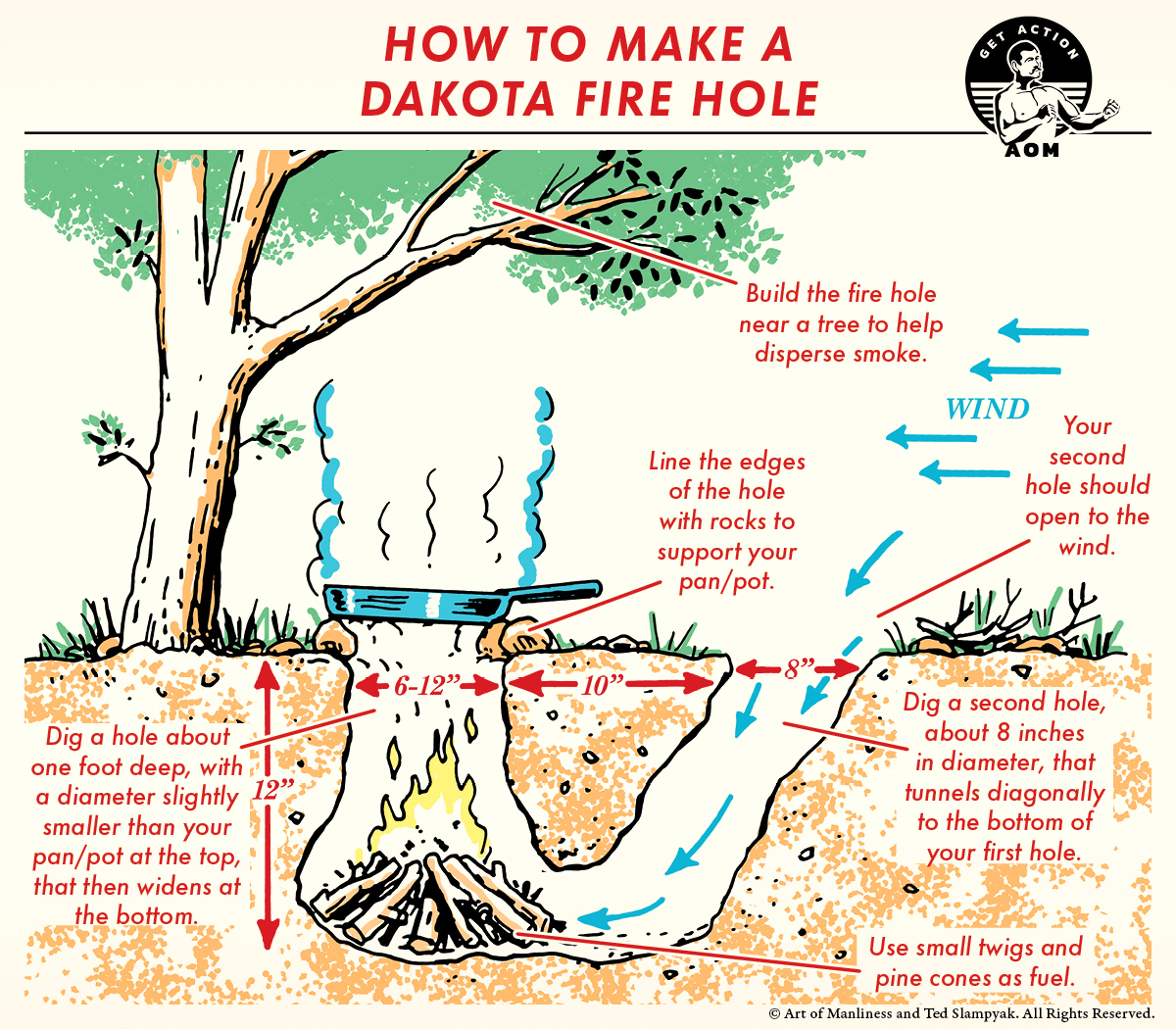Post by oldhippy on Oct 6, 2019 18:46:52 GMT

There are countless ways to make a fire, and each one has its benefits. We’ve shown you how to make a Swedish Torch, how to build a summer fire, and many more. Now, it’s time to visit an ancient methodology known as the Dakota fire hole — the fire-building technique of choice when you’re trying to evade a human tracker.
Dakota fire holes were often used by American Indians to create easily concealed, highly efficient fires that burned clean, even in windy conditions. Dakota fire holes are not what you want if you’re trying to create a big bonfire to warm you and a bunch of friends. But, they are ideal for cooking and for staying hidden if you’re trying to have a fire without being seen.
Dakota fire holes work by creating two holes that connect at the bottom. One hole should be made in a vertical orientation while the other should angle down to connect to the first hole’s base. When you make a fire in the vertical hole, air is drawn into the angled hole to feed the fire with oxygen. Because of the concentrated air supply, only a handful of twigs or pine cones are required for fuel. And, by placing rocks around the lip of your vertical hole, you can create an ideal surface to set a pot or pan on for cooking. As for tending: you can toss in more twigs to keep the flames going, as well as tend to the fire with a longer stick (remember that the fire is just a foot down, so it’s still accessible).
Beyond the diagram above, there are only a couple other things to know about creating an effective fire hole:
First, learn how to detect wind direction, because you should always locate the second hole you make — your air supply hole — in the direction that the wind is coming from. In some cases, wind direction is obvious. But, if it’s calm out, try wetting your entire index finger and then holding it up in the air. Whichever side of your finger feels cooler is the windward side.
Second, remember to keep the dirt you excavated to fill in your holes when you’re done. Not only does this extinguish the fire fully, but it also helps to conceal any evidence that you were there. If digging your hole required removing vegetation, like plants or grasses, carefully replace them to take your concealment one step further.
Dakota fire holes were often used by American Indians to create easily concealed, highly efficient fires that burned clean, even in windy conditions. Dakota fire holes are not what you want if you’re trying to create a big bonfire to warm you and a bunch of friends. But, they are ideal for cooking and for staying hidden if you’re trying to have a fire without being seen.
Dakota fire holes work by creating two holes that connect at the bottom. One hole should be made in a vertical orientation while the other should angle down to connect to the first hole’s base. When you make a fire in the vertical hole, air is drawn into the angled hole to feed the fire with oxygen. Because of the concentrated air supply, only a handful of twigs or pine cones are required for fuel. And, by placing rocks around the lip of your vertical hole, you can create an ideal surface to set a pot or pan on for cooking. As for tending: you can toss in more twigs to keep the flames going, as well as tend to the fire with a longer stick (remember that the fire is just a foot down, so it’s still accessible).
Beyond the diagram above, there are only a couple other things to know about creating an effective fire hole:
First, learn how to detect wind direction, because you should always locate the second hole you make — your air supply hole — in the direction that the wind is coming from. In some cases, wind direction is obvious. But, if it’s calm out, try wetting your entire index finger and then holding it up in the air. Whichever side of your finger feels cooler is the windward side.
Second, remember to keep the dirt you excavated to fill in your holes when you’re done. Not only does this extinguish the fire fully, but it also helps to conceal any evidence that you were there. If digging your hole required removing vegetation, like plants or grasses, carefully replace them to take your concealment one step further.
IF YOU FEEL THIS IS YOUR FORUM TOO! Enjoy the conversation! Post your opinion below PLS. What do you think about what's in this post?
REGISTER NOW! It's free and takes just a few minutes.












